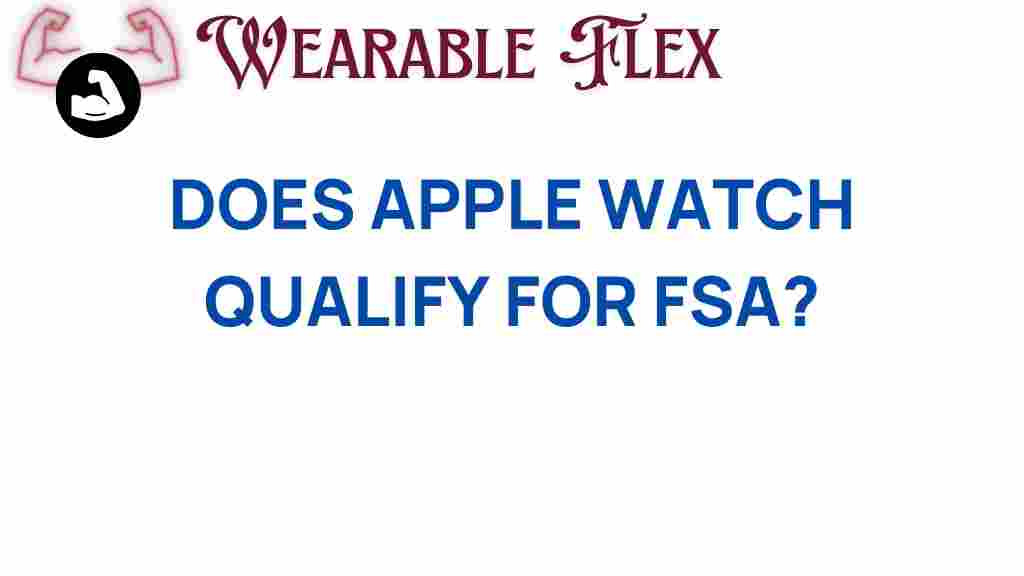Does the Apple Watch Qualify for FSA?
The Apple Watch has become a popular device for health and wellness tracking, but many consumers are left wondering: does the Apple Watch qualify for Flexible Spending Accounts (FSA)? In this article, we will unpack the benefits of the Apple Watch and explore how it fits into the FSA landscape. Whether you’re considering purchasing one or already own one, understanding FSA eligibility can help you maximize your health spending.
Understanding Flexible Spending Accounts (FSA)
Before diving into the specifics of the Apple Watch, let’s clarify what an FSA is and how it works. A Flexible Spending Account is a pre-tax benefit account offered by employers that allows employees to set aside money for eligible healthcare expenses. Here are some key points:
- Pre-Tax Savings: Contributions to an FSA reduce your taxable income.
- Eligible Expenses: FSAs can be used for a variety of medical expenses, including prescriptions, co-pays, and certain over-the-counter items.
- Use-It-or-Lose-It Rule: Generally, funds not used by the end of the plan year may be forfeited, although some plans offer a grace period or allow a small amount to carry over.
How the Apple Watch Fits into FSA Eligibility
Now that we understand what an FSA is, let’s examine the Apple Watch. The Apple Watch is equipped with various health-focused features, such as:
- Heart rate monitoring
- Activity tracking
- ECG capabilities
- Sleep tracking
- Fall detection
These features can be beneficial for individuals managing chronic health conditions or those looking to improve their overall wellness. But does that make the Apple Watch an eligible expense under FSA guidelines? Let’s break it down.
FSA Eligibility Criteria for the Apple Watch
To determine if the Apple Watch qualifies for FSA, we need to consider a few factors:
- Medical Necessity: The IRS allows certain medical devices to be purchased with FSA funds if they are deemed medically necessary.
- Doctor’s Prescription: For many medical devices, including the Apple Watch, a prescription from a healthcare provider may be required.
According to IRS guidelines, the Apple Watch can qualify for FSA reimbursement if:
- It is prescribed by a healthcare provider for a specific medical condition.
- You can demonstrate that it is used primarily for medical purposes, such as monitoring a heart condition or managing diabetes.
Step-by-Step Process to Use Your FSA for an Apple Watch
If you’re interested in using your FSA funds to purchase an Apple Watch, follow these steps:
- Consult Your Healthcare Provider: Discuss whether the Apple Watch could be beneficial for your health condition. If they agree, request a prescription.
- Check FSA Guidelines: Review your FSA plan details to ensure that the Apple Watch qualifies and understand the reimbursement process.
- Purchase the Apple Watch: Buy the device from an authorized retailer. Keep the receipt as proof of purchase.
- Submit for Reimbursement: Fill out the necessary forms provided by your FSA administrator. Attach the prescription and receipt as documentation.
- Receive Reimbursement: Wait for the FSA administrator to process your request and issue reimbursement if your claim is approved.
Benefits of Using Apple Watch for Health Monitoring
Investing in an Apple Watch can provide several health benefits, particularly if used as part of a broader wellness strategy. Here are some of the key benefits:
- Real-Time Health Monitoring: The Apple Watch can provide immediate feedback on your health metrics, allowing for timely interventions.
- Encouragement to Stay Active: Activity tracking features can motivate users to meet fitness goals.
- Integration with Health Apps: The Apple Watch seamlessly integrates with various health and fitness apps, enhancing its functionality.
Troubleshooting Common Issues
While the Apple Watch is a powerful tool for health management, users may encounter some issues. Here are common problems and their solutions:
- Battery Life: If your Apple Watch is draining quickly, try disabling background app refresh and reducing screen brightness.
- Sync Issues: If your watch isn’t syncing with your iPhone, ensure Bluetooth is enabled and restart both devices.
- Health Data Not Updating: Make sure your health app permissions are enabled and check if you’re connected to Wi-Fi.
Conclusion
The Apple Watch can indeed qualify for FSA reimbursement under certain conditions. If prescribed by a healthcare provider and used for medical purposes, it can be an eligible expense. With its extensive health monitoring features, the Apple Watch not only serves as a fashionable accessory but also plays a crucial role in managing health and wellness. If you’re considering using FSA funds for an Apple Watch, follow the necessary steps to ensure a smooth reimbursement process.
For more information on FSA eligibility and other health-related topics, check out this comprehensive guide. And remember to consult with your healthcare provider to determine if the Apple Watch is the right choice for your health needs.
Investing in your health is a priority, and the Apple Watch can be a valuable tool in that journey.
This article is in the category Health and created by WearableFlex Team

3 thoughts on “Does the Apple Watch Qualify for FSA? Unpacking the Benefits”